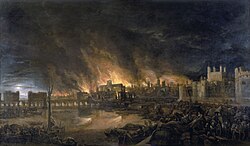17th century
- 1608 –First settlement in Jamestown, Virginia burnt.
- 1615 – Great Fire of Wymondham, Norfolk, England, two simultaneous fires destroyed 300 properties.
- 1624 – Oslo, Norway, destroyed by fire.
- 1625 – First Great Stockholm Fire, Sweden, burned for three days and destroyed a fifth of the infrastructure.
- 1633 – Great Istanbul Fire of 1633, Ottoman Empire, modern Turkey, started in the Cibali Gate Port due to a reckless caulker, burned for three days from early Friday morning to Sunday. About 20,000 buildings and all the ships docked on the Cibali Gate Port were demolished.
- 1652 – Glasgow, Scotland, a third of the city destroyed and over 1,000 families left homeless. [4]
- 1653 – Great Fire of Marlborough, England, destroyed the Guildhall, St Mary's Church, the County Armoury, and 224 dwellings.
- 1656 –Fire of Aachen destroys 4,664 houses, kills 17.
- 1657 – Great Fire of Meireki destroys two-thirds of the Japanese capital Edo (modern-day Tokyo). [5]
- 1660 –Fire in Istanbul, Turkey, destroys two-thirds of the city and kills an estimated 40,000 people. [6]
- 1663 –Great Fire of Nagasaki destroys the port of Nagasaki in Japan. [7]

- 1666 – Great Fire of London of 1666, which originated in a baker's shop on Pudding Lane and destroyed much of London.
- 1675 – Great Fire of Northampton, England. The blaze was caused by sparks from an open fire in St. Mary's Street near Northampton castle. In 6 hours it devastated the town centre, destroying about 600 buildings (three-quarters of the town) including All Saints church. 11 people died and about 700 families were made homeless.
- 1676 – Jamestown, Virginia was burned by Nathaniel Bacon and his followers during Bacon's Rebellion to prevent Governor Berkley from using it as a base.
- 1677 –Fire of Rostock, Germany, destroys 700 houses and accelerates the city's economic decline at the end of the Hanseatic period.
- 1678 – Hardegsen. Germany, experienced a fire during the Christmas fair that destroyed most of the town centre. There were no injuries as people were in church.
- 1684 – Toompea (part of modern Tallinn), a fire destroyed most of the hilltop-town.
- 1689 – Fire of Skopje of 1689, present-day capital of North Macedonia is burned.
- 1692 –Two-thirds of Usingen, Germany, is razed, later replaced by a baroque town centre.
- 1694 – Great Fire of Warwick, England
- 1696 – St. John's, Newfoundland, and 35 other settlements were burned by French forces under Pierre Le Moyne d'Iberville.


